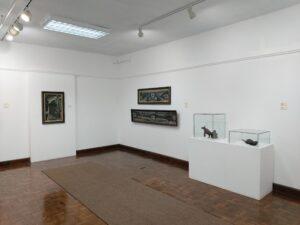“Narrative Evolutions”-The way forward? Part 3

For much of the history of the National Gallery of Jamaica (NGJ), which will be 50 years old next year, there have been broad assumptions regarding its mandate, general functions, and underlying vision, but these are under-articulated and need to be updated, as this lack of clarity of purpose has contributed to the institution’s troubles. The mission statement, which was articulated about 20 years ago, reads as follows: “To collect, research, document and preserve Jamaican, other Caribbean Art and related material and to promote our artistic heritage for the benefit of present and future generations.” While generic, this mission statement at least acknowledges that the core functions of the NGJ are its public ones.
In recent years, there has been global debate about museums and the need to decolonize their operations and the values and agendas upon which they are premised, and to become more responsive to their communities. There has, however, been only limited museum activism and debate in the Caribbean, and very little published literature on the subject. The time has come for such conversations to take place in Jamaica, and to involve local museums such as the NGJ.

We need to ask what museums are here to do, whose interests they are supposed to serve, how they should engage with stakeholders and audiences, and what perspectives they should represent in their exhibitions, publications and programmes. We also need to ask whether the traditional, hierarchical governance and operational models, including the “national gallery” designation, are relevant here, and what other, more appropriate approaches could take their place. These are not things that can be decided on in a closed board retreat but require comprehensive, inclusive, and well-informed stakeholder consultations. Facilitating such a conversation, and responding imaginatively and effectively to its outcomes, could be a real game-changer for the NGJ, and for museums in the Caribbean in general.
Along with such general rethinking, urgent improvement is needed regarding the NGJ’s handling of its exhibitions and programmes. Museums normally plan ahead for at least five years. This is not only necessary to the effective management of resources, funding, and operations, but it also ensures that the exhibitions and programmes are sufficiently diverse and balanced, and cover the range of what is expected from that museum. Naturally there needs to be some flexibility, in case of unexpected circumstances (as we had recently with the pandemic), but such a “big picture” approach seems to be lacking at the NGJ. The strong focus on the Biennial, and its appeals to international prestige and visibility, appears to have resulted in insufficient attention to what would follow, hence the eleventh-hour, ad hoc approach to this year’s exhibition programme. However, the Biennial and whatever “open call” exhibition it will now alternate with cannot be the sole anchors of the NGJ’s exhibition programme, with mere “fillers” in-between. There also need to be retrospectives, historical and thematic exhibitions, and exhibitions that serve specific, developmental purposes such as young artist exhibitions, just to name a few types.
Tellingly, there has been no retrospective since the Barrington Watson retrospective in 2012, and the last Young Talent exhibition was in 2015, although that exhibition series has launched the careers of several Jamaican artists. Retrospectives require significant preparation, as they need to present a comprehensive, scholarly sound investigation of an artist’s work, but the NGJ should certainly be able to produce two per decade. The wait list includes Gloria Escoffery, Osmond Watson, Hope Brooks, Colin Garland, Milton George, and David Boxer, all artists who are rapidly dropping from the public consciousness, yet there is no word on whether any of these are forthcoming.
The question is, however, whether the NGJ currently has the capacity to produce such exhibitions, as it has all but stopped producing new research and critical scholarship. There is at present no art historian on staff, for the first time since David Boxer was appointed in 1975. With “art historian” I mean someone who studied in a structured Art History programme and who, furthermore, has a solid record of original research and scholarly publications, and other discipline-related work, ideally in subject area that is directly relevant to the museum’s mandate. I am not suggesting that persons with adjacent qualifications cannot make important contributions, but not having even one art historian on staff is unusual for a museum that is supposed to be the institution of reference for art historical scholarship in and about Jamaica.
The bigger point is, of course, that cultural institutions cannot afford to be cavalier with its human resources. There have been too many “own goals” with regard to HR practices in the Jamaican cultural sector in recent years. Specialist skills may be scarce, locally, but there are well-regarded Jamaican professionals in the diaspora. Many would be happy to return if the circumstances are sufficiently attractive, not only in terms of salaries and resources but also in terms of a wholesome work environment. The same general needs and expectations also apply to the local professionals, as there is obviously significant demoralization. The structure, development and welfare of the NGJ staff, and the circumstances under which they work, need urgent attention, as the current situation will get worse if staff members continue to opt out.
On my most recent visit, I viewed the reinstalled Dunkley gallery. There is no air conditioning, resulting in sweltering temperatures, which is detrimental to the conservation of Dunkley’s delicate paintings and carvings. The blinding white walls and ceiling, and blaring lights are completely inappropriate to Dunkley’s work and there is nothing in the room to contextualize it. The building and facilities at the NGJ are indeed another pressing matter, along with ill-advised curatorial practices that aggravate these problems.
The NGJ moved into its building on the Kingston Waterfront in 1982-83, as what was supposed to be a temporary, five-year arrangement while a new building was constructed, but it has been in these “temporary” facilities ever since. There needs to be a firm decision on whether the NGJ should in fact remain there, with due consideration for new environmental hazards such as sea level rise. There were plans for an international architectural competition and fundraising campaign to redevelop the building, but these appear to have evaporated. At the very least, the building needs to be stripped and reconfigured to accommodate the NGJ’s evolving needs, and equipped with up-to-date and functional infrastructure. It is a pity that this was not done during the extended pandemic closure. There is new carpet upstairs, which seems like a waste, as replacing the antiquated flooring with museum-quality, high-traffic flooring would have been much wiser.
The building, which was originally intended to house a Woolworth’s department store, is in essence an open concrete shell, which has been configured with plywood partitions. That is not recommended for a museum, because of the health, conservation, termite, and fire hazards involved. Lighting is an unsightly hodgepodge unsuitable for a major museum and also needs to be upgraded. The antiquated central air-conditioning system, for which spare parts are no longer available, should have been removed years ago and upgraded to an energy-efficient, museum-quality climate control system. It is also time for the NGJ building to become wheelchair accessible, with an elevator and bathrooms on both floors, as it is not compliant with the accessibility standards that are now in effect for public buildings. None of this is beyond the reasonable reach of the NGJ.
There are many other things that need urgent attention at the NGJ – a communications policy being one – but I have outlined some of the most pressing issues. Hopefully, by the time the next exhibition opens in December, there will have been some positive action.
Dr Veerle Poupeye is an art historian specialized in art from the Caribbean. She works as an independent curator, writer, researcher, and cultural consultant. The second, revised and expanded edition of her best-known book “Caribbean Art” was recently published in the World of Art series of Thames and Hudson. Her personal blog can be found at veerlepoupeye.com.



![Thomas Rowlandson (1756–1827) and Augustus Charles Pugin (1762–1832) (after) John Bluck (fl. 1791–1819), Joseph Constantine Stadler (fl. 1780–1812), Thomas Sutherland (1785–1838), J. Hill, and Harraden (aquatint engravers)[1]](https://monitortribune.com/wp-content/uploads/2022/02/2022-02_Microcosm_of_London_Plate_006_-_Auction_Room_Christies_colour_1-768x577.jpg)


